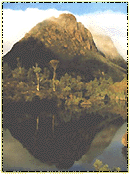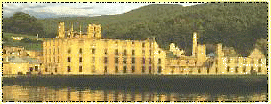 |
 |
 |
|
|||
|
Touring Tasmania Tasmania's often been compared with Scotland and there are similarities, but it's a lot warmer! Here you get a bit of everything history, wildlife, wonderful scenery and action. Our first stop is Cradle Mountain.
The fly fishing here is some of the best in the world and it's Duncan's job to pass on the art to tourists like me. Poor soul! So picture the scene: we've put on a pair of giant rubber wellies and are wading out into the middle of the lake with our rods. Duncan gives an expert demonstration. It seems all you do is wave the rod backward and forward in the air letting out a bit of line all the time and eventually you stop and the fly lands gently on the water on the end of a viscous little hook. It's several meters away from you, and looking pretty and juicy for a passing trout. You're a hunter. Only your grace and guile will trap the wily fish.
Perhaps I should try something else! Now this is easier. We're riding through a 40,000-year-old forest. Well, I say "riding," basically the horse knows what it's doing, I'm just holding on tight! Leading the way is Errol Wattley, and what a character.
This whole area, the mountain itself, the lakes and the forests, is a world heritage park. We're staying at the Cradle Mountain luxury lodge. It's run by P&O. We've got a log cabin, a wood fire and our nearest neighbor is a wallaby! It's stunning here. But it's time to head south to the island's capital, Hobart, and a night in one of the many colonial style guest houses. Ours was run by a Hungarian called Zsa Zsa and, yes, she did call us "daaaahlings"! It's worth a day wandering around Hobart building up your strength for our next port of call Here at Port Arthur they used the cat-o'-nine-tail. This is a whip and it has nine strings in it. In those nine strings, 81 knots were tied but that was not enough. They would often soak it in the salt water and dry it in the sun. And they say that when it came down upon your back it felt like barbed wire. Yuk!
The guides here do seem to enjoy the gore. It's a fascinating place and many of the old buildings still remain: the convict prisons, the lunatic asylum, the houses for the soldiers and the prison governor.
Three years ago a mad gunman went on the loose at Port Arthur. Many staff know those who died and you need to be sensitive about that. A lot of evil things have happened here. And yet this is a place where beauty triumphs: the harbor, the hills -- it's a place of calm. A few hours drive up the east coast I meet one of the survivors of the massacre, Neville Quinn, who runs the Bicheno wildlife park. He was shot in the neck at Port Arthur, his wife died of her wounds, his mother died of shock on hearing the news. But this isn't a place of gloom either -- it's teeming with life: kangaroos, wombats, parrots. Neville says they keep him going. He introduces me to the famous Tasmanian Devil, a black, cat-size creature with a ferocious reputation. Watch those teeth! They can apply 400lb per square inch so if they get you by the hand. It's just like putting your hand in a vice and screwing it up and they just cut it straight off. I didn't stroke it! For its wildlife, its mountains, coastline and historical guest houses alone, Tasmania is worth adding to the itinerary of any holiday Down Under. A visit to Port Arthur is emotionally exhausting, but adds an extra dimension to the trip. Nowhere in Australia will you get a more graphic view of the country's convict past and the human capacity for evil. But it's so beautiful there you can't help but leave thinking the world is still a wonderful place. For More Information:
|
 | American Public Media Home | Search | How to Listen ©2004 American Public Media | Terms of Use | Privacy Policy |



